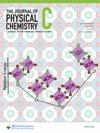近红外发光纳米荧光粉 Bi3+/Yb3+掺杂的 RE2MoO6(RE = Gd、Y 和 Lu)和 Gd2Mo1-xWxO6 的发光调谐
IF 3.3
3区 化学
Q2 CHEMISTRY, PHYSICAL
引用次数: 0
摘要
近红外纳米磷酸盐因其广泛的应用领域而备受关注,包括成分分析、生物成像和晶体硅太阳能电池(c-Si)的太阳光光谱转换器。Yb3+ 离子可在 1000 纳米左右发出近红外(NIR)荧光,这与晶体硅的第一生物窗口和最大响应范围一致。因此,我们利用溶热反应工艺,重点研究并成功合成了掺杂 Bi3+/Yb3+ 的近红外发光纳米磷酸盐 RE2MoO6:Bi3+,Yb3+(RE=Gd、Y 和 Lu)和 Gd2Mo1-xWxO6:Bi3+,Yb3+(x = 0-0.5)。在紫外线(UV)激发和宽带激发下,所有样品都表现出 Yb3+ 离子的近红外发光,这是由于 O 2p/Bi 6s 和 Mo 4d 或 W 5d 轨道之间的电荷转移转变所致,其光学特性包括光致发光(PL)、PL 激发(PLE)和反射光谱。此外,为了评估 Gd2MoO6:Bi,Yb (GMO:Bi,Yb)纳米荧光粉对晶体硅转换效率的贡献,使用二甲基聚硅氧烷(PDMS)和 GMO:Bi,Yb 纳米荧光粉制作了荧光粉转换薄膜。结果表明,使用 PDMS/GMO:Bi,Yb 薄膜的晶体硅转换效率高于仅使用 PDMS 薄膜的晶体硅转换效率。基于这些结果,利用下移纳米磷化物能够提高晶体硅的转换效率,从而有利于应对未来的能源挑战。本文章由计算机程序翻译,如有差异,请以英文原文为准。

Luminescence Tuning of NIR Luminescence Nanophosphor Bi3+/Yb3+-Doped RE2MoO6 (RE = Gd, Y, and Lu) and Gd2Mo1–xWxO6
Near-infrared nanophosphors have attracted attention due to their wide application fields, including component analysis, bioimaging, and spectral converters of sunlight for crystalline silicon solar cells (c-Si). Yb3+ ions exhibit near-infrared (NIR) luminescence at around 1000 nm, which is consistent with the first biological window and the maximum responsivity range of c-Si. Therefore, we focused on and successfully synthesized Bi3+/Yb3+-doped NIR luminescence nanophosphors, RE2MoO6:Bi3+,Yb3+ (RE=Gd, Y, and Lu) and Gd2Mo1–xWxO6:Bi3+,Yb3+ (x = 0–0.5), utilizing a solvothermal reaction process. All samples exhibit NIR luminescence of Yb3+ ions under ultra-violet (UV) light excitation and broadband excitation due to the charge transfer transition between the O 2p/Bi 6s and Mo 4d or W 5d orbitals, indicated by their optical properties of photoluminescence (PL), PL excitation (PLE), and reflectance spectra. Furthermore, to evaluate the contribution of the Gd2MoO6:Bi,Yb (GMO:Bi,Yb) nanophosphor to the conversion efficiency of c-Si, a phosphor-converted film was made using dimethylpolysiloxane (PDMS) and the GMO:Bi,Yb nanophosphor. The results showed that the conversion efficiency of c-Si with the PDMS/GMO:Bi,Yb film is higher than that of c-Si with the PDMS-only film. Based on these results, the utilization of down-shifting nanophosphors is able to enhance the conversion efficiency of c-Si, which could be beneficial in addressing future energy challenges.
求助全文
通过发布文献求助,成功后即可免费获取论文全文。
去求助
来源期刊

The Journal of Physical Chemistry C
化学-材料科学:综合
CiteScore
6.50
自引率
8.10%
发文量
2047
审稿时长
1.8 months
期刊介绍:
The Journal of Physical Chemistry A/B/C is devoted to reporting new and original experimental and theoretical basic research of interest to physical chemists, biophysical chemists, and chemical physicists.
 求助内容:
求助内容: 应助结果提醒方式:
应助结果提醒方式:


